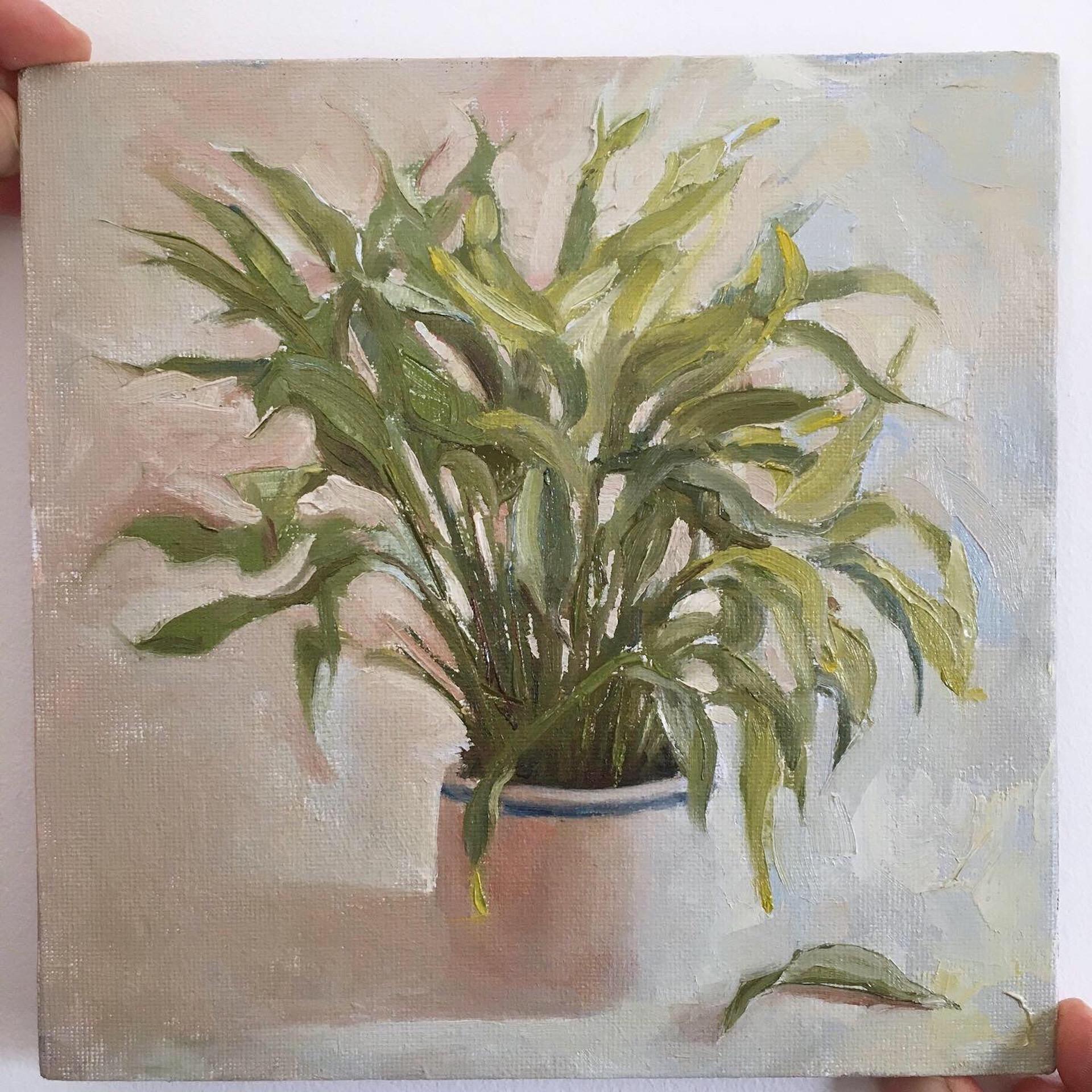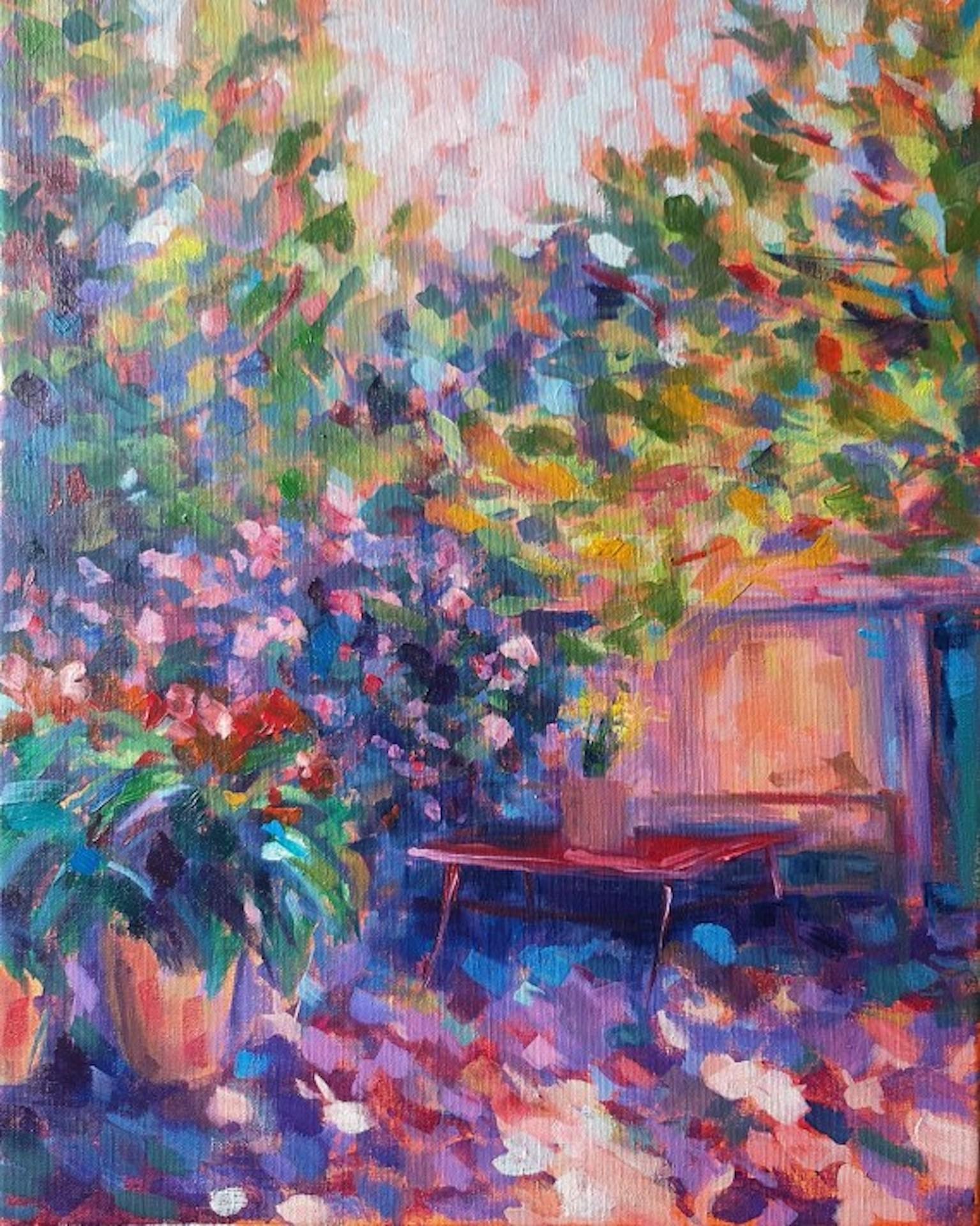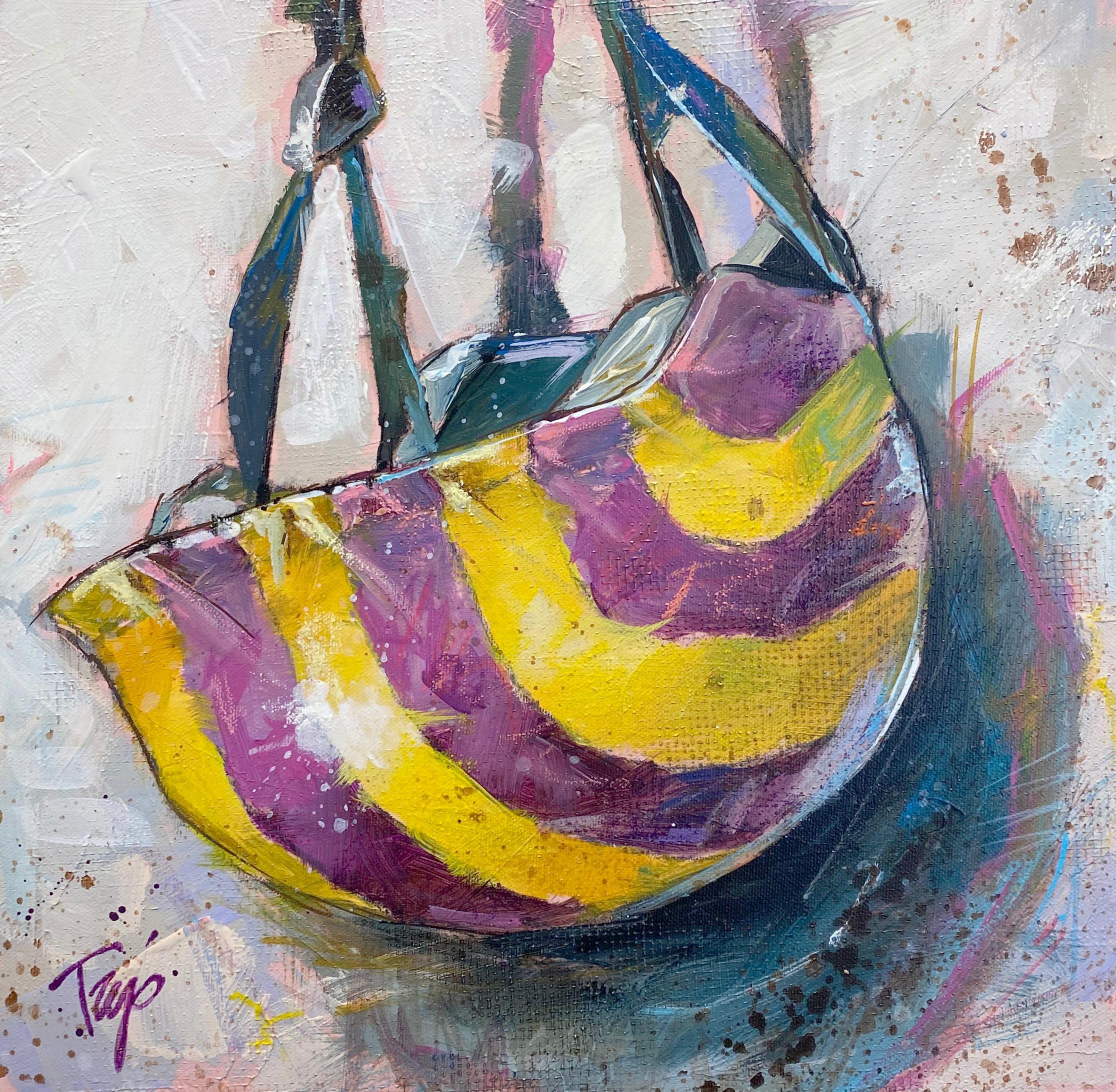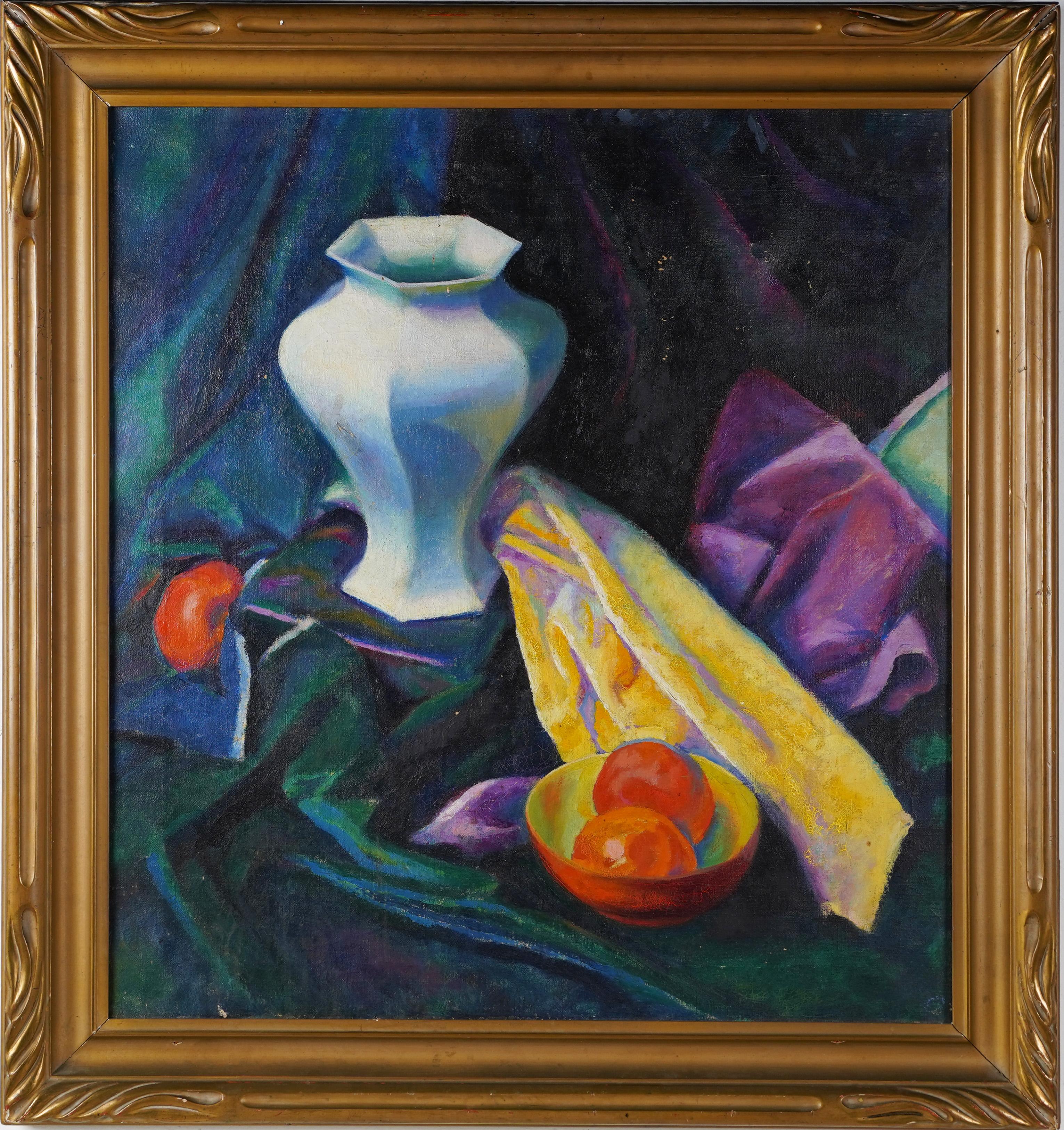Items Similar to Nature morte au pot à pipe - Impressionist Oil, Still Life by Jean Albert Pougny
Want more images or videos?
Request additional images or videos from the seller
1 of 11
Jean PougnyNature morte au pot à pipe - Impressionist Oil, Still Life by Jean Albert Pougny1942
1942
About the Item
A wonderful still life oil on canvas by French painter Jean Albert Pougny depicting a pipe sitting in a pot on a patterned cloth. Signed lower right. Framed dimensions are 10 inches high by 9.5 inches wide.
Provenance:
Collection Michel Moncey, Paris.
Galerie Louis Carré, Paris
Further information: Exhibitions:
Pougny, Oeuvres récentes, Galerie Louis Carré, Paris, 1943.
Bibliography :
Herman Berninger, Jean-Albert Cartier, Jean Pougny 1892-1956, Catalogue de l'œuvre, Tome 2
Paris - Côte d'Azur, 1924-1956, Peintures, Tübingen, Éditions Ernst Wasmuth, 1992, n° 701, reproduced p. 184.
This work is included in the Pougny archives under number 700-283B.
Jean Albert Pougny, whose real name was Ivan Puni, was of Italian descent: his grandfather was the composer César Puni and his father was a violinist. He was attracted to art from an early age, but from 1900 to 1908 was educated in the corps of cadets at St Petersburg, despite having no interest in the army. During 1908-1909 he received an academic education and in 1910 he spent his first period of time in Paris, where he was a student at the Académie Julian and other private academies, and was very impressed by Fauvism and Cubism. In 1912 he travelled to Italy, then returned to St Petersburg and married Xenia Bogouslavskaya. (She survived him by many years, coming almost every day to put flowers on his Russian Orthodox grave in Montparnasse Cemetery.) In 1913-1914 he again went to Paris, returning to St Petersburg after the declaration of war in 1914 and becoming friends there with Maïakovski and Khlebnikov.
In 1915 he organised two historic exhibitions in St Petersburg: First Exhibition of Tramway V Futurist Paintings and Last Futurist Exhibition of 0.10 Paintings, in which Cubo-Futurist works were shown for the first time. These two exhibitions echoed in St Petersburg the artistic events of the Jack of Diamonds group in Moscow. It was from these various group artistic events that the more specifically Russian movement of the international avant-garde would detach itself. This movement, called Constructivism, took clearer shape in the Suprematism of Malevich and Tatlin, whose manifesto Pougny signed in 1916.
He was mobilised in 1917, and in 1918, after the October Revolution, he was appointed a lecturer at the academy of fine art in Petrograd (St Petersburg). In 1918 he took part in the decoration of the streets of Petrograd for the celebration of the anniversary of the Revolution: 'The streets will be our paintbrushes', declared Mayakovski. Extending his revolutionary ideas into art, he joined the Constructive Realism movement, which was to become Formalism. In 1919 he moved to Vitebsk to teach at the academy set up and directed by Chagall, but when Zhdanov stigmatised the avant-garde movements, he left the USSR for Finland. From 1920 to 1922 he lived in Berlin, becoming part of the Russian colony of artists there and meeting Hans Richter, Eggeling and Van Doesburg. In July 1923 he created the stage scenery and costumes for a Polish play at the Prague Opera. In 1923-1924 he moved to Paris, where he settled permanently, becoming close friends with Fernand Léger, Amédée Ozenfant, Marcoussis and Séverini. In 1940 he moved to Antibes with Robert Delaunay, before returning to Paris in 1942. After his French naturalisation in 1946, he was appointed a Chevalier of the Légion d'Honneur in 1947.
From his early days in St Petersburg, Pougny was encouraged by Repine, who painted a Portrait of Tolstoy. At the time of his visit to Paris in 1913-14, he was evolving in a Cubist direction. In Tramway V in 1915, Pougny showed a dozen paintings of Cubist inspiration and a relief, The Card Players. In the same year, he showed at 0.10 the 'alogical' painting (in a description coined by Malevich) The Hairdresser, in which he depicted a collection of unusual objects with a text by Mayakovski: 'Through the window pane sparkles the button that one does not see...' He also showed a board painted green, a premonition of future monochromes, and a still-life consisting of a hammer hanging from a nail on three sheets of paper of different colours. In this painting, in his words, 'the object is free of meaning', and he was foreshadowing Dadaism, although an aesthetic concern with presentation is already present. He also executed totally abstract compositions in Indian ink.
After the limited innovations of the two historic exhibitions, in his first series of paintings Pougny, in a Cubist style tending to total Abstraction, integrated groups of letters, or even complete texts (as in the painting BHK of 1916) into geometric coloured plans. Again in 1916, foreshadowing Dadaist approaches, he set a china plate on a board. After the Revolution, radicalising his first innovations, he took more and more liberties with the flatness of the canvas, producing reliefs, 'pictorial sculptures', in polychrome cardboard and wood, incorporating letters, numbers and everyday items as well as magnified objects. In these works, colour played a predominant role, although in general colour was absent from the works of the other artists produced by the Revolution (apart from Malevich), who felt colour stemmed from bourgeois superfluity. After 1918, along with his aesthetic demand for the use of colour, his natural evolution distanced him from the rigours of both revolutionary art and Suprematism. He returned to Cubo-Futurism in 'Realist Formalism', again integrating elements of reality in compositions with a geometric and faintly Suprematist tendency. This phase ended with The Synthetic Musician of 1921, which was close to Synthetic Cubism, apart from the frankly volumetric modulation of the face, and with drawings of urban subjects, in which the narrative and dynamic subject coexists with static geometric organisation: 'basically, Suprematism remains an experimental construction within the painting'.
In 1924, after he had finally settled in Paris, he began to use pure pigment to obtain subtle refinements in the expression of colour. At this time he was moving away from his previous abstract work into hybrid compositions of Post-Cubism with Surrealist borrowings. In his last period, starting around 1935, he began to paint interiors, street scenes, harlequins, landscapes and still-lifes. Though these works were of undoubted originality, he was probably influenced by Vuillard. Under the hand of the man who from then on signed himself Jean Pougny, all the intimate fairy-tale themes for which Vuillard used quite large formats were reduced to the most modest scale. There is a great charm in these compositions. He creates atmosphere with subtle combinations of toned-down colours, uses layers of pigments, and prepares his canvases by trampling on them to produce cracking, which he puts across as a nostalgia for the ravages of time.
Pougny, who became less innovative after his Suprematist and Constructivist periods, was a painter loved by painters. In his apparent renunciation of the pursuit of modernity, he knew how to preserve and celebrate what was for him the essential thing: the pleasure of painting.
Pougny took part in group exhibitions, including: 1912, St Petersburg, Union of Youth; 1914, Paris, Salon des Indépendants; 1915, St Petersburg, Tramway V, with Malevich, Tatlin, Exter and Oudaltsova; 1915-16, 0.10, with Malevich and Tatlin; 1923, Berlin, Great Berlin Art Exhibition, Novembergruppe; 1924, Paris, first Salon des Tuileries, of which he became one of the most faithful participants; 1925, Paris, Salon d'Automne; 1931 Paris, Galerie Katia Granoff and Galerie Paul Rosenberg; 1935, Paris, Galerie Jeanne Castel; 1946, Vienna and Cairo; then France, Moscow and Brussels; 1949, travelling exhibition in several American museums; 1950, Pittsburgh, Carnegie Foundation exhibition; 1951, Menton Biennale; and after his death: 1977, Paris, Historical Aspects of Constructivism and Concrete Art, Musée d'Art Moderne de la Ville de Paris; 1979, Paris Paris-Moscow, Centre Georges Pompidou; 2003, Russian Paris 1910-1960, an exhibition on Russian art and artists in Paris, organised by the Russian Museum of St Petersburg, presented at the Von der Heydt-Museum in Wuppertal, and then at the Musée des Beaux-Arts in Bordeaux.
He often exhibited as an individual: 1915, exhibition of drawings, Galerie Dobitchine, Petrograd; 1921, Galerie Der Sturm, Berlin; 1925, an exhibition prefaced by Henri Salmon, Galerie Barbazanges, Paris; 1926, Paris; 1933, an exhibition organised and prefaced by Paul Guillaume, and which confirmed his new style, Galerie Jeanne Castel, Paris; 1943, Galerie Louis Carré, Paris; 1947, after obtaining French nationality, an important exhibition prefaced by Charles Estienne, Galerie de France, Paris; 1949, first exhibition, Knoedler Gallery, New York; 1950, Adams Brothers Gallery in London and Galerie de France in Paris; 1952, Knoedler Gallery, New York; 1950, Adams Brothers Gallery in London and Galerie de France in Paris; 1952, Knoedler Gallery, New York; 1953, 1956, Galerie Coard, Paris. After his death, numerous retrospectives were devoted to his work: 1958, Musée National d'Art Moderne, Paris; and then Albi, St-Étienne and Clermond-Ferrand; 1959, Galerie Coard, Paris; 1960, Musée des Beaux-Arts, Zurich; 1961, Galerie Charpentier, Paris; 1960, Stedelijk Museum, Amsterdam; 1962, Galleria d'Arte Moderna, Turin; 1964, Bibliothèque Nationale, Paris; 1964, Kunsthalle, Baden-Baden; 1966, exhibition of the Donation Pougny, Musée de l'Orangerie des Tuileries, Paris; 1980, Galerie Bellint, Paris; 1989, Musée Bourdelle, Paris; 1997, Galerie Coard, Paris; 2003, Galerie Zlotowski, Paris; 2003, Ivan Puni, Works from the Berninger Collection, Musée Jean Tinguely, Basel.
Museum and Gallery Holdings:
Albi (Mus. Toulouse-Lautrec): Woman at a Blue Easel (1938-1939); Landscape
Algiers (Mus. National des Beaux-Arts): Garden (1949)
Amsterdam (Stedelijk Mus.)
Berlin (Berlinische Gal.): Synthetic Musician (1921)
Cologne: Man with Top Hat
Grenoble (Mus. de Grenoble): Interior; Landscape
Limoges: Landscape
Moscow: Bouquet of Lilac
New York (MoMA)
Paris (BNF, Prints Collection): donation of linocut works
Paris (MAMVP): Chair, Violin and Globe
Paris (MNAM-CCI, Pougny Bequest): Self-portrait (1912); Chair and Violin Case (1914-1915, ink); Revolution (1914-1920, colour linograph); Aerial Bridge (1914-1920, colour linograph); Cellist (1914-1920, colour linograph); Vitebsk (1914-1920, colour linograph); Interior (1914-1920, colour linograph); Door (1914-1920, colour linograph); Staircase (1914-1920, colour linograph); Gangway (1914-1920, colour linograph); Entrance to the House (1914-1920, colour linograph); Hairdresser (1915); White Ball (1915); Interior with Mannequin (1915-1916, ink); Violin (1919); Still-life with Ball (1921); Bottle and Glove (1921-1922, red pencil and gouache); Bottle and Alarm Clock (1928-1929); Woman Seated (1939-1940, watercolour and gouache); Chair and Plate of Fruit (1939-1942); Seated Model (1942-1943, pencil, charcoal, ink and oil); Woman with Red Hat (1942-1943, gouache); Chair and Piano (1944); Studio (1944-1945); Mother and Child (1945, charcoal); Figure in an Armchair (1946-1948, pencil); Study of an Interior (c. 1948, pencil); Head of Harlequin (1950); Man Reading in an Interior (1950); Woman Seated near a Painting (1950, pencil); Man Seated (1952, pencil); Seine (1953); Public Garden (1954); Interior with Piano (1955); At the Races (1956)
Prague (Národní Muz.): Still-life
St Petersburg (Gosudarstvennyj Russkij Muz.): Still-life with Letters (1919)
Strasbourg: Still-life
- Creator:Jean Pougny (1894 - 1956, Russian)
- Creation Year:1942
- Dimensions:Height: 8 in (20.32 cm)Width: 7.5 in (19.05 cm)
- Medium:
- Movement & Style:
- Period:
- Condition:Very good original condition.
- Gallery Location:Marlow, GB
- Reference Number:
About the Seller
5.0
Platinum Seller
These expertly vetted sellers are 1stDibs' most experienced sellers and are rated highest by our customers.
Established in 2001
1stDibs seller since 2016
668 sales on 1stDibs
Typical response time: 3 hours
- ShippingRetrieving quote...Ships From: Marlow, United Kingdom
- Return PolicyA return for this item may be initiated within 3 days of delivery.
More From This SellerView All
- Flowers & Fan - Impressionist Oil, Still Life of Roses by Georges JeanninBy Georges JeanninLocated in Marlow, BuckinghamshireSigned and dated impressionist still life oil on original canvas by French painter Georges Jeannin. The work depicts a bouquet of pink, white and red roses with a paper fan placed in...Category
1890s Impressionist Still-life Paintings
MaterialsCanvas, Oil
- Bouquet de tulipes et de pivoines - Impressionist Still Life Oil by Leon DetroyBy Leon DetroyLocated in Marlow, BuckinghamshireSigned still life oil on canvas circa 1930 by French impressionist painter Leon Detroy. The work depicts a bronze vase filled with tulips in an array of autumnal colours, and peonies...Category
1930s Impressionist Still-life Paintings
MaterialsOil, Canvas
- Voyage au Venezuela 1919 - Impressionist Seascape Oil Painting by Emilio BoggioLocated in Marlow, BuckinghamshireSigned and dated oil on canvas seascape by French impressionist painter Emilio Boggio. The piece in a view of the vast, open ocean - a rich blue sea with white ocean foam leading to ...Category
1910s Impressionist Landscape Paintings
MaterialsCanvas, Oil
- Fleurs au pot de gres rose - Fauvist Still Life Oil Painting by Charles CamoinBy Charles CamoinLocated in Marlow, BuckinghamshireSigned still life oil on canvas by French expressionist and fauvist painter Charles Camoin. The work depicts a bright bouquet of flowers in reds, yellows, blues and pinks in a stoneware vase. Signature: Signed lower right Dimensions: Framed: 36"x28" Unframed: 29"x21" Provenance: Galerie Marcel Bernheim Exhibitied: Paris, Galerie Druet, March 1929, n°23 This work is included in the Archives Camoin and a certificate from Madame Grammont-Camoin is available on request Charles Camoin was the son of a paint manufacturer in Marseilles who died when Charles was six years old. His mother travelled extensively, absenting herself for long periods at a time, and Camoin's studies suffered accordingly. At 16, he enrolled at a commercial college in Marseilles, but also attended courses at the École des Beaux-Arts, where he was awarded a first prize for drawing and composition. In 1896, at the age of 17 (or in 1898 according to other, possibly more reliable sources), Camoin moved to Paris where he was admitted to Gustave Moreau's class at the École des Beaux-Arts, shortly before the latter's death. He soon left on his travels in the company of Albert Marquet - no doubt following Moreau's advice to 'go and paint buses', his recommendation to the two artists to search out their subject matter on the streets and in the cabarets of Paris. During his short time in Moreau's class Camoin made a number of lasting friendships, notably with artists who would go on to pioneer Fauvism: Henry Manguin, Georges Roualt and, in particular, Jean Puy and Henri Matisse, with whom he exchanged letters on a regular basis.In 1900, Camoin did his military service, first in Arles, where he painted compositions inspired by Van Gogh motifs, then in 1902 in Aix, where he frequently met with Cézanne, with whom Camoin maintained a life-long correspondence and whose advice and counsel he cited repeatedly. In 1903, Camoin exhibited for the first time - at the Salon des Artistes Indépendants in Paris. The following year (1905), he met Claude Monet (at Cézanne's instigation and, appropriately perhaps, underneath Giverny's Nympheas); he then held his first solo exhibition at the Berthe Weill Gallery in Paris. In 1905, Camoin exhibited alongside the 'Animals' at that year's Salon d'Automne, although it must be said that he did not share the graphic and chromatic violence of a Matisse or a Derain...Category
1920s Impressionist Still-life Paintings
MaterialsCanvas, Oil
- Le Jardin - Impressionist Landscape Oil Painting by Bernard Boutet de MonvelBy Bernard Boutet de MonvelLocated in Marlow, BuckinghamshireSigned and dated impressionist oil on canvas landscape by French painter, engraver, sculptor and fashion illustrator Bernard Boutet de Monvel. The work depicts a view of the artist's garden in Nemours, France. The house is concealed by two large, bare trees. A path runs through the neatly landscaped flower beds. Signature: Signed & dated 1906 lower left Dimensions: Framed: 27.5"x32.5" Unframed: 21"x26" Provenance: Private French collection Bernard Boutet de Monvel was the son of Louis Boutet de Monvel and first studied under his father. He went on to study under Luc-Olivier Merson and the sculptor Jean Dampt...Category
Early 1900s Impressionist Landscape Paintings
MaterialsCanvas, Oil
- Fleurs a l'eventail - Impressionist Still Life Oil of Flowers by Marie DuhemBy Marie DuhemLocated in Marlow, BuckinghamshireSigned and titled still life oil on canvas circa 1900 by French impressionist painter Marie Duhem. This stunning piece depicts pink and yellow roses in a white ceramic vase with a fan resting beside it. A truly beautiful painting. Signature Signed lower left and titled on original label verso Dimensions: Framed: 25"x29" Unframed: 18"x22" Provenance: The collection of the artist's family Marie Duhem's parents operated a lace factory, so she became familiar with the work of designers and models from an early age. She began her art studies with Adrien Demont...Category
Early 1900s Impressionist Still-life Paintings
MaterialsCanvas, Oil
You May Also Like
- Angela Gordon-Webb, Beautiful Pear, Original Bright Still Life PaintingLocated in Deddington, GBAngela Gordon Webb Beautiful Pear The pears were sitting on my windowsill in the sun to ripen and then the colour and light caught my eye. I love to take ...Category
21st Century and Contemporary Impressionist Still-life Paintings
MaterialsCanvas, Oil
- Benedict Flanagan, Peace Lily, Original Still Life Painting, Contemporary ArtBy Benedict FlanaganLocated in Deddington, GBBenedict Flanagan Peace Lily Original Impressionist Landscape Painting Oil on Canvas Board Board Size: H 20cm x W 20cm x D 0.5cm Sold Unframed (Please note ...Category
21st Century and Contemporary Impressionist Still-life Paintings
MaterialsCanvas, Oil, Board
- Moroccon Garden, Charmaine Chaudry, Original Landscape Painting, Affordable ArtBy Charmaine ChaudryLocated in Deddington, GBMoroccan Garden [2021] original Oil on canvas Image size: H:50 cm x W:40 cm Complete Size of Unframed Work: H:50 cm x W:40 cm x D:1.8cm Sold Unframed...Category
21st Century and Contemporary Impressionist Still-life Paintings
MaterialsCanvas, Oil
- Trip Park, "Striper Head", 16x16 Contemporary Jockey Helmet Painting on CanvasLocated in Saratoga Springs, NYThis colorful piece, "Striper Head", is a 16x16 acrylic painting on canvas featuring a single jockey helmet with purple and yellow stripes. Park's signature pink underpainting can be...Category
2010s Impressionist Abstract Paintings
MaterialsOil, Canvas
- Antique American School Impressionist Flower Still Life Signed Framed PaintingLocated in Buffalo, NYAntique American impressionist flower still life signed oil painting. Oil on canvas. Signed. Framed. Image size, 25.5L x 21.5H.Category
1920s Impressionist Still-life Paintings
MaterialsCanvas, Oil
- Antique Exhibited American Impressionist 1921 Flower Still Life Oil PaintingLocated in Buffalo, NYAntique American impressionist still life oil painting by Kathryn Logan Luke. Oil on canvas, circa 1921. Housed in a period giltwood frame. Image size, 24L x 26H.Category
1920s Impressionist Still-life Paintings
MaterialsCanvas, Oil
Recently Viewed
View AllMore Ways To Browse
Italian Vintage Life
Faces Still Life Art
Still Life By Window
Mother Nature Paintings
Still Life French 1920
Vintage Van Life
Herman Stilling
Baden Baden
Russian Impressionist Painters
Period French Impressionist Oil Paintings
Still Life Cubism
Painted Large Pot
Geometric Abstract Still Life Painting
Albert Green
Man Reading
Russian Impressionist Portrait
Large Flower Pot
Play A Piano





